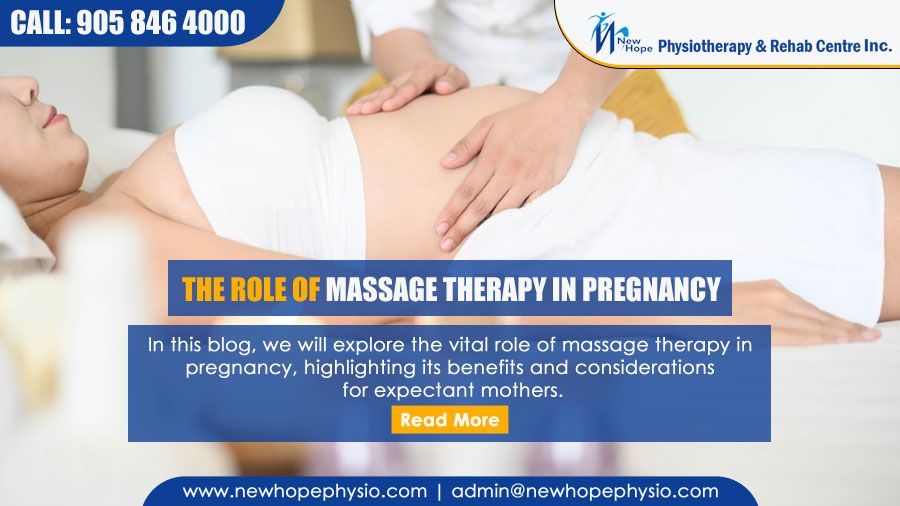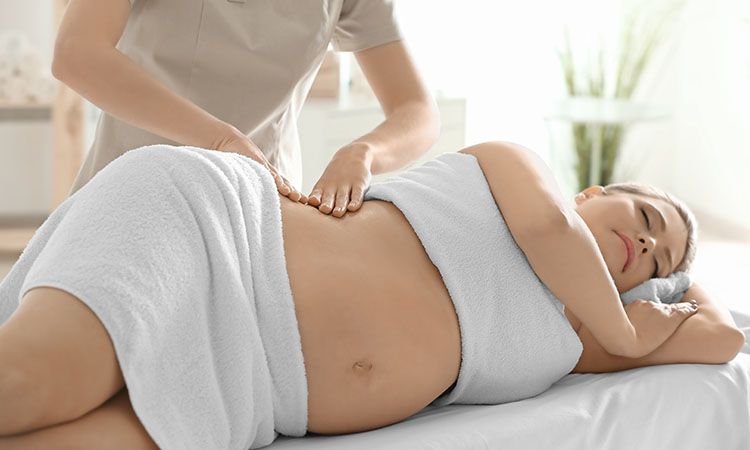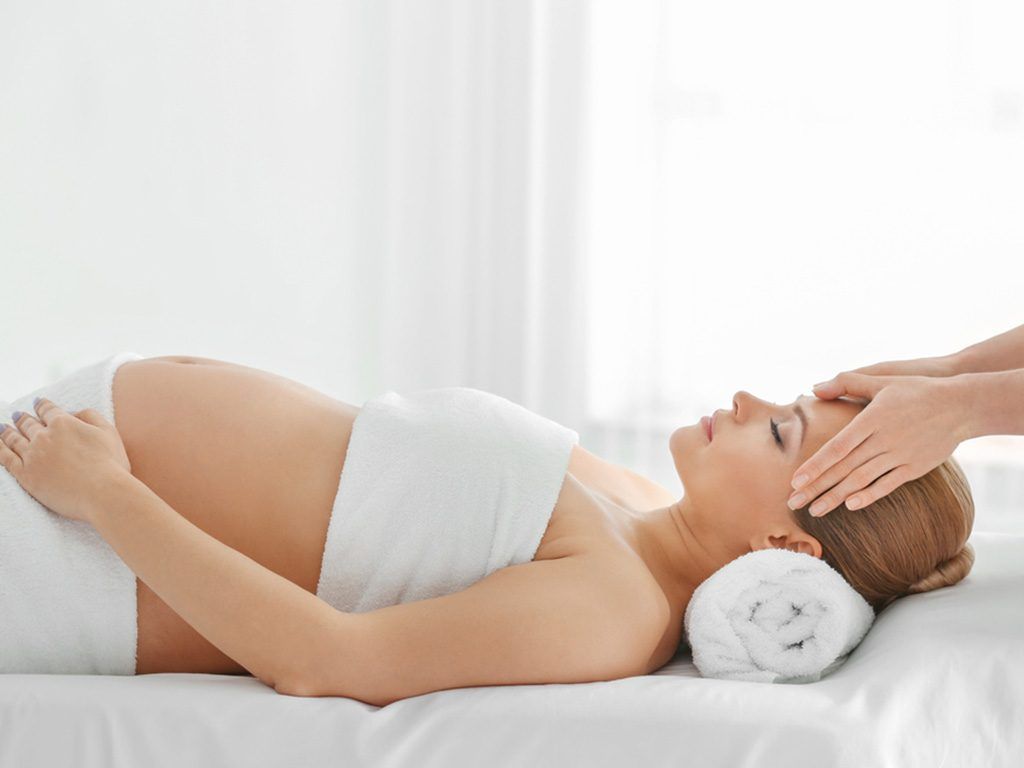
Welcome to the professional physiotherapy clinic
- Home
- Blog
The Role of Massage Therapy in Pregnancy: Promoting Wellness and Comfort
 29 May 2023
29 May 2023
The Role of Massage Therapy in Pregnancy: Promoting Wellness and Comfort
Pregnancy is a remarkable journey that brings joy and anticipation for expectant mothers. However, it also comes with various physical and emotional challenges. Fortunately, massage therapy offers a safe and effective way to support women throughout their pregnancy. In this blog, we will explore the vital role of massage therapy in pregnancy, highlighting its benefits and considerations for expectant mothers.
Understanding the Benefits of Prenatal Massage
During pregnancy, a woman’s body undergoes a remarkable transformation to nurture and support the growing life within. Prenatal massage, specifically tailored for expectant mothers, plays a crucial role in promoting overall well-being and enhancing the pregnancy experience. Let’s delve into the various benefits of receiving regular prenatal massages, massage therapy in pregnancy.
1. Reducing Muscle Tension and Improving Flexibility
As the baby grows, the mother’s body undergoes significant changes in posture and weight distribution, often leading to muscle tension, stiffness, and discomfort. Prenatal massage helps relieve muscular tension and tightness by using gentle techniques that focus on specific areas of concern. This can help improve flexibility, enhance range of motion, and promote better alignment of the body.
2. Enhancing Circulation and Reducing Edema
Pregnancy can sometimes cause swelling, particularly in the extremities, due to reduced circulation and increased pressure on blood vessels. Prenatal massage stimulates blood flow and lymphatic drainage, aiding in the reduction of edema (swelling). By enhancing circulation, massage therapy promotes the delivery of vital nutrients and oxygen to both the mother and the baby.
3. Alleviating Back, Neck, and Joint Pain
As the pregnancy progresses, the body’s center of gravity shifts, placing additional strain on the back, neck, and joints. This can lead to discomfort and pain. Massage therapy in pregnancy techniques, such as gentle strokes and kneading, target these areas, providing relief from common complaints like lower back pain, sciatica, and neck tension.
4. Easing Digestive Issues and Constipation
Hormonal changes during pregnancy can affect digestion, leading to issues like heartburn, indigestion, and constipation. Prenatal massage can help stimulate the digestive system, promote bowel movements, and alleviate gastrointestinal discomfort. It can also help relieve pressure on the diaphragm, allowing for improved breathing and reduced reflux symptoms.
5. Lowering Stress and Anxiety Levels
Pregnancy can be an emotionally challenging time, with hormonal fluctuations and increased responsibilities adding to the stress and anxiety experienced by expectant mothers. Massage therapy in pregnancy induces a relaxation response in the body, promoting the release of endorphins, which are natural mood elevators. This can help reduce stress and anxiety, improving the overall emotional well-being of the mother.
6. Improving Sleep Quality
Many pregnant women experience difficulties with sleep due to discomfort, hormonal changes, and increased anxiety. Prenatal massage promotes relaxation, reduces muscle tension, and encourages the release of serotonin, a hormone that aids in sleep regulation. By improving sleep quality, massage therapy contributes to the mother’s overall physical and emotional well-being.
7. Bonding and Connection with the Baby
Massage provides an opportunity for expectant mothers to connect with their babies on a deeper level. The gentle touch and nurturing environment created during prenatal massage sessions can enhance the bond between mother and child, fostering a sense of love, security, and relaxation for both.
It’s important to note that massage therapy in pregnancy should be performed by a qualified and experienced massage therapist who specializes in working with pregnant women. They have the knowledge and expertise to ensure the safety and comfort of both the mother and the baby throughout the massage session.

By understanding the multitude of benefits that prenatal massage offers, expectant mothers can make informed decisions about including this valuable practice as part of their prenatal care routine. Consult with your healthcare provider and a qualified prenatal massage therapist to discuss how prenatal massage can be tailored to meet your specific needs and provide optimal support during this special time.
Promoting Physical Well-being During Pregnancy
Pregnancy is a beautiful journey, but it can also bring about physical discomfort and challenges. Prenatal massage serves as a valuable tool in promoting and maintaining physical well-being throughout the different stages of pregnancy. Let’s explore how massage therapy can address common physical concerns and enhance overall wellness.
1. Relieving Musculoskeletal Discomfort
The physical changes that accompany pregnancy, such as weight gain, postural adjustments, and hormonal shifts, can put strain on the muscles, joints, and ligaments. Massage therapy in pregnancy utilizes gentle techniques to target specific areas of tension and pain, providing relief from musculoskeletal discomfort. It helps relax tight muscles, release tension, and improve overall mobility and flexibility.
2. Improving Circulation and Reducing Swelling
During pregnancy, hormonal changes and the pressure from the growing uterus can impede circulation, leading to swelling in the hands, feet, and ankles. Prenatal massage promotes blood and lymphatic flow, helping to reduce edema and minimize swelling. By improving circulation, massage therapy enhances the delivery of oxygen and nutrients to both the mother and the baby.
3. Enhancing Posture and Body Alignment
As the baby grows, the body’s center of gravity shifts, placing additional stress on the spine and joints. This can lead to postural imbalances and discomfort. Prenatal massage techniques, such as gentle stretching and joint mobilization, can help improve posture and body alignment. By addressing postural issues, massage therapy reduces strain on the muscles and joints, promoting better balance and alleviating discomfort.
4. Alleviating Back and Pelvic Pain
Back pain and pelvic discomfort are common complaints during pregnancy. The weight of the growing baby, along with hormonal changes and ligament laxity, can contribute to these issues. Massage therapy in pregnancy focuses on relieving tension in the lower back, hips, and pelvic area through targeted techniques and stretches. It helps alleviate pain, increase flexibility, and restore balance to the affected areas.
5. Enhancing Digestive Function
Pregnancy hormones can impact digestion, leading to issues such as heartburn, indigestion, and constipation. Prenatal massage stimulates the digestive system, promoting better digestion and alleviating discomfort. The gentle strokes and movements applied during the massage can aid in relieving digestive issues, allowing for improved nutrient absorption and waste elimination.
6. Boosting Energy Levels and Reducing Fatigue
The physical demands of pregnancy, combined with hormonal changes and the body’s efforts to support fetal development, can result in fatigue and low energy levels. Prenatal massage helps stimulate the release of endorphins, which are natural mood enhancers, and improves circulation, increasing oxygen supply to the muscles and tissues. This can provide a revitalizing effect, boost energy levels, and reduce pregnancy-related fatigue.
7. Strengthening the Immune System
Maintaining a strong immune system is essential during pregnancy to protect both the mother and the baby from illness and infections. Prenatal massage promotes relaxation and reduces stress, which can help bolster the immune system. By reducing stress hormones and enhancing overall well-being, massage therapy contributes to a healthier immune response.

By incorporating prenatal massage into their wellness routine, expectant mothers can experience physical benefits that support their overall well-being massage therapy in pregnancy. Remember to consult with a qualified prenatal massage therapist and your healthcare provider to ensure the safety and appropriateness of massage therapy for your specific needs.
Alleviating Pregnancy Discomforts with Massage
Pregnancy brings about a myriad of discomforts, ranging from morning sickness to swollen feet. Fortunately, prenatal massage can be a valuable tool in alleviating these common pregnancy discomforts. Let’s explore how massage therapy can provide relief and enhance the overall well-being of expectant mothers.
1. Morning Sickness and Nausea Relief
Morning sickness, often characterized by feelings of nausea and vomiting, can significantly impact a woman’s well-being during the early stages of pregnancy. While massage cannot directly alleviate morning sickness, certain techniques can help reduce stress and promote relaxation, potentially minimizing the severity of symptoms. Gentle pressure on specific points, such as the wrist or the back of the neck, can be soothing and provide temporary relief.
2. Headache and Migraine Management
Pregnancy hormones, changes in blood circulation, and increased stress levels can contribute to headaches and migraines during pregnancy. Prenatal massage, with its focus on relaxation and stress reduction, can help manage these symptoms. By targeting tension in the head, neck, and shoulders, massage therapy can help alleviate headache pain and promote overall relaxation.
3. Backache and Sciatic Nerve Pain Relief
As the uterus expands, it can put strain on the lower back and cause discomfort. Additionally, the pressure on the sciatic nerve can result in sciatica, characterized by pain, tingling, or numbness radiating down the leg. Prenatal massage employs techniques to specifically address back pain and sciatic nerve pain. By applying gentle pressure and stretches to the affected areas, massage therapy in pregnancy can help alleviate pain, release tension, and improve overall comfort.
4. Leg Cramp Reduction and Swelling Alleviation
Pregnant women often experience leg cramps, especially during the later stages of pregnancy. Swollen feet and ankles are also common due to reduced circulation and increased fluid retention. Prenatal massage can help reduce leg cramps by increasing blood flow and releasing muscle tension in the legs. Additionally, by stimulating lymphatic drainage, massage therapy can assist in reducing swelling and promoting healthier circulation.
5. Relief from Hip and Pelvic Pain
As pregnancy progresses, the pelvis undergoes changes to accommodate the growing baby, which can result in discomfort and pain in the hips and pelvic area. Massage therapy in pregnancy techniques that target the hip muscles and pelvic joints can provide relief by reducing tension, improving flexibility, and promoting better alignment. This can enhance overall comfort and mobility during daily activities.
6. Improved Sleep Quality
Many expectant mothers experience difficulty sleeping due to physical discomfort, hormonal changes, and anxiety. Prenatal massage promotes relaxation and reduces muscle tension, leading to improved sleep quality. By increasing the release of endorphins and inducing a state of calm, massage therapy can help pregnant women achieve a more restful and rejuvenating sleep.
7. Emotional and Psychological Support
Pregnancy is a time of significant emotional and psychological changes. Expectant mothers may experience increased stress, anxiety, and mood swings. Prenatal massage provides a nurturing and calming environment, allowing women to relax, unwind, and release stress. The soothing touch and focused attention during the massage can contribute to emotional well-being and promote a sense of balance and tranquility.

By incorporating prenatal massage into their routine, expectant mothers can find relief from various pregnancy discomforts and enhance their overall well-being. It is important to consult with a qualified prenatal massage therapist and your healthcare provider to ensure that massage therapy is safe and appropriate for your specific situation.
The Emotional Benefits of Prenatal Massage
Pregnancy is not just a physical journey; it also brings about a range of emotional changes and challenges. Prenatal massage offers more than just physical relief—it can have profound positive effects on an expectant mother’s emotional well-being. Let’s explore the emotional benefits that prenatal massage provides during this transformative time.
1. Stress Reduction and Relaxation
Pregnancy often comes with increased stress levels as expectant mothers navigate the physical and emotional changes that accompany this period. Prenatal massage creates a calming and nurturing environment that promotes deep relaxation. The gentle touch and soothing strokes used during the massage release tension, ease muscle discomfort, and help lower stress hormone levels. This overall relaxation can provide expectant mothers with a much-needed respite from the daily stresses of pregnancy.
2. Anxiety and Mood Improvement
Pregnancy can trigger a range of emotions, including anxiety and mood swings, as hormone levels fluctuate and new responsibilities arise. Prenatal massage encourages the release of endorphins, which are natural mood enhancers. These feel-good chemicals help reduce anxiety and uplift the mood, creating a sense of emotional balance and well-being. The nurturing touch and supportive presence of a skilled prenatal massage therapist can also provide comfort and emotional reassurance.
3. Connection and Bonding
The experience of receiving a prenatal massage provides expectant mothers with an opportunity to connect with their unborn baby on a deeper level. As the therapist’s hands glide over the belly, it can evoke a sense of connection and bonding between mother and child. This nurturing touch can foster a deeper emotional connection and enhance the mother’s sense of love and attachment to her baby.
4. Body Positivity and Self-Care
Pregnancy can bring about changes in body image and self-esteem. Prenatal massage promotes body positivity by creating a safe and accepting space where the mother’s body is honored and celebrated. The positive touch and care received during the massage can help expectant mothers feel more confident and connected to their changing bodies. It serves as a reminder of the importance of self-care and nurturance during this transformative time.
5. Improved Sleep Quality
The physical discomfort and hormonal changes of pregnancy can often disrupt sleep patterns, leading to fatigue and emotional instability. Prenatal massage promotes relaxation, reduces muscle tension, and induces a state of calm, all of which can contribute to improved sleep quality. By experiencing restful sleep, expectant mothers wake up feeling refreshed and emotionally restored, better equipped to handle the challenges of pregnancy.
6. Mind-Body Connection and Emotional Awareness
Prenatal massage encourages expectant mothers to tune into their bodies and be present in the moment. As they become more attuned to the physical sensations and changes within, it can heighten their emotional awareness. This increased mindfulness can empower mothers to better navigate their emotional landscape, fostering emotional resilience and self-awareness.
7. Emotional Support and Therapeutic Relationship
Prenatal massage provides a supportive and therapeutic relationship between the expectant mother and the massage therapist. The therapist’s understanding and empathetic presence can create a safe space for the mother to express her emotions, concerns, and fears. This emotional support can be invaluable during pregnancy, helping women feel heard, validated, and cared for.

By incorporating prenatal massage into their self-care routine, expectant mothers can nurture their emotional well-being, find relief from stress and anxiety, and foster a deeper connection with their growing baby. It is essential to seek the services of a qualified prenatal massage therapist who specializes in working with pregnant women to ensure a safe and beneficial experience.
Safety Considerations for Prenatal Massage
While prenatal massage offers numerous benefits for expectant mothers, it is crucial to prioritize safety during pregnancy. Before receiving a prenatal massage, it’s important to be aware of certain safety considerations to ensure a positive and risk-free experience. Here are some key points to keep in mind:
1. Consultation with Healthcare Provider
Before scheduling a prenatal massage, it is essential to consult with your healthcare provider. They can evaluate your specific pregnancy conditions and provide guidance on whether prenatal massage is suitable for you. Certain high-risk pregnancies or medical conditions may require modifications or contraindicate massage therapy. Your healthcare provider will have the necessary knowledge and information to assess the appropriateness of prenatal massage for your unique situation.
2. Qualified Prenatal Massage Therapist
Choosing a qualified prenatal massage therapist is crucial to ensure a safe and effective session. Look for a therapist who has specialized training and experience in prenatal massage. They should be knowledgeable about the anatomical and physiological changes that occur during pregnancy and be skilled in adapting massage techniques to meet the unique needs and considerations of pregnant clients.
3. Massage Techniques and Pressure
Prenatal massage employs gentle techniques and modified positions to ensure the safety and comfort of the mother and baby. Deep tissue massage and certain intense pressure techniques, such as trigger point therapy, are generally avoided during pregnancy. The therapist will use lighter pressure and focus on soothing and relaxation techniques. Communication with your therapist is essential; inform them about any discomfort or pain during the session, and they can adjust their techniques accordingly.
4. Positioning during the Massage
The positioning during a prenatal massage is crucial to prevent undue pressure on the abdomen and ensure the mother’s comfort. Many therapists use specialized cushions, bolsters, or pregnancy-specific massage tables that allow the expectant mother to lie on her side or semi-reclined position. Side-lying position is commonly used during the later stages of pregnancy to avoid putting pressure on the vena cava, a large vein that returns blood from the lower body to the heart. Your therapist will make sure you are positioned safely and comfortably throughout the session.
5. Avoiding Certain Areas and Techniques
There are specific areas and techniques that are generally avoided or modified during prenatal massage. Pressure points on the ankles, wrists, and certain points on the feet should be avoided to prevent potential uterine contractions. Deep abdominal massage is also avoided, especially during the first trimester. Instead, the focus is on areas such as the back, shoulders, neck, hips, and legs, which can provide relief and relaxation without posing any risk.
6. Sensitivity to Aromatherapy and Allergens
Some expectant mothers may have increased sensitivity to certain scents and aromatherapy oils during pregnancy. It’s important to communicate any sensitivities or allergies you may have to the massage therapist before the session. They can adjust their use of oils or avoid them altogether to ensure your comfort and safety.
7. Pregnancy Complications and High-Risk Conditions
If you have any pregnancy complications, such as preeclampsia, gestational diabetes, placenta previa, or a history of preterm labor, it is essential to inform your massage therapist and healthcare provider. These conditions may require specific precautions or contraindications for massage therapy. Always prioritize the guidance of your healthcare provider to ensure the safety of you and your baby.

Remember, prenatal massage should always be performed by a trained professional who specializes in working with pregnant women. By being proactive, communicating your needs and concerns, and following the guidance of your healthcare provider, you can enjoy the benefits of prenatal massage while keeping safety as a top priority.
Disclaimer: The information provided in this article is for educational purposes only and should not be considered as a substitute for medical advice. Always consult with your healthcare provider before undergoing any form of therapy during pregnancy.
Finding a Qualified Prenatal Massage Therapist
When seeking a prenatal massage therapist, it’s important to find a qualified professional who has the knowledge, skills, and experience to provide safe and effective care during pregnancy. Here are some key considerations to help you find a qualified prenatal massage therapist:
1. Certification and Training
Look for a prenatal massage therapist who has received specialized training in prenatal massage. They should have certifications or qualifications that demonstrate their expertise in working with pregnant clients. The therapist should have a deep understanding of the anatomical and physiological changes that occur during pregnancy and how to adapt massage techniques accordingly. Certifications from reputable organizations such as the National Certification Board for Therapeutic Massage and Bodywork (NCBTMB) or specific prenatal massage training programs are good indicators of a therapist’s competence.
2. Experience with Pregnant Clients
While certification and training are important, experience working with pregnant clients adds an extra level of expertise. A therapist who has regularly worked with pregnant women will be familiar with the unique needs and considerations that arise during pregnancy. They will understand how to modify positions, techniques, and pressure to ensure the safety and comfort of both the mother and baby. Inquire about the therapist’s experience and how many pregnant clients they have treated.
3. Referrals and Recommendations
Seek recommendations from other expectant mothers or healthcare professionals who specialize in prenatal care. They may be able to provide referrals to qualified prenatal massage therapists they have worked with or received positive feedback about. Personal recommendations can give you insights into the therapist’s professionalism, skills, and overall experience.
4. Communication and Listening Skills
A qualified prenatal massage therapist should have excellent communication and listening skills. They should take the time to understand your specific needs, concerns, and any pregnancy-related discomforts you may be experiencing. The therapist should ask detailed questions about your medical history, pregnancy progress, and any complications you may have. They should also be attentive and responsive during the session, adjusting their techniques and pressure based on your feedback.
5. Safe and Comfortable Environment
Ensure that the massage therapist provides a safe and comfortable environment for prenatal massage. The facility should be clean and well-maintained, with appropriate equipment and amenities to support the unique needs of pregnant clients. Specialized cushions, bolsters, or pregnancy-specific massage tables should be available to ensure your comfort and proper positioning during the session.
6. Professionalism and Ethics
A qualified prenatal massage therapist should adhere to professional standards and ethical practices. They should maintain client confidentiality, respect your privacy and boundaries, and provide a professional and nurturing atmosphere. Look for therapists who are members of professional organizations and follow a code of ethics, which ensures a high level of professionalism and quality care.
7. Consultation with Healthcare Provider
A reputable prenatal massage therapist will always request a consultation with your healthcare provider before providing services. This step ensures that they have a clear understanding of any specific medical conditions, complications, or contraindications related to your pregnancy. It also demonstrates their commitment to prioritizing your safety and well-being.

By considering these factors and doing thorough research, you can find a qualified prenatal massage therapist who can provide safe, effective, and supportive care during your pregnancy journey. Remember to always consult with your healthcare provider and follow their guidance when seeking any form of therapy during pregnancy.
What to Expect During a Prenatal Massage Session
Knowing what to expect during a prenatal massage session can help you feel more comfortable and prepared for the experience. Here is an overview of what typically happens during a prenatal massage session:
1. Initial Consultation
Before your first prenatal massage session, you will likely have an initial consultation with the massage therapist. They will discuss your medical history, pregnancy progress, any specific concerns or discomforts you may have, and your expectations for the session. This consultation allows the therapist to customize the massage to address your individual needs and ensure a safe and effective treatment.
2. Comfortable Environment
The massage session will take place in a calm, soothing, and private environment. The room may be dimly lit, with soft music playing in the background to create a relaxing ambiance. The therapist will ensure the room temperature is comfortable for you, but if at any point during the session you feel too hot or cold, don’t hesitate to communicate your needs.
3. Clothing and Draping
During a prenatal massage, you will typically undress to your comfort level. Most therapists recommend undressing down to your underwear, but you can choose to keep your undergarments on if you prefer. The therapist will provide you with sheets or towels to drape over your body, ensuring your privacy and only exposing the areas being worked on. They will use proper draping techniques to maintain your comfort and modesty throughout the session.
4. Positioning and Support
Pregnant women may have difficulty lying flat on their back for extended periods due to the pressure it can exert on the vena cava, a large vein that returns blood from the lower body to the heart. Instead, the therapist will typically position you on your side with supportive cushions, bolsters, or specialized pregnancy massage tables. These supports help you find a comfortable and safe position that alleviates pressure on certain areas while allowing access to areas that need attention.
5. Techniques and Pressure
The therapist will use a variety of techniques during the massage to promote relaxation, alleviate discomfort, and address specific concerns. They will typically focus on areas such as the back, shoulders, neck, hips, and legs. The techniques used will be gentle and soothing, with lighter pressure compared to regular massage therapy. The therapist will modify their techniques and pressure based on your comfort level and feedback. Remember to communicate any discomfort or pain, as well as areas you would like them to focus on.
6. Communication and Feedback
Open communication with your massage therapist is crucial throughout the session. If you have any concerns, discomfort, or if the pressure feels too light or too intense, don’t hesitate to let the therapist know. They will adjust their techniques and pressure accordingly to ensure your comfort and safety. Your feedback during the session helps the therapist tailor the treatment to your specific needs.
7. Duration of the Session
The duration of a prenatal massage session can vary but is typically around 60 to 90 minutes. However, shorter or longer sessions may be available depending on your preference and the therapist’s recommendations. The therapist will discuss the duration of the session with you during the initial consultation and ensure that you have an adequate amount of time to fully relax and receive the benefits of the massage.
8. Aftercare and Self-Care Suggestions
After the massage session, the therapist may provide you with aftercare instructions and self-care suggestions. This may include recommendations for stretches, exercises, or relaxation techniques that you can practice at home to prolong the benefits of the massage. They may also suggest ways to maintain proper posture, manage stress, and promote overall well-being during your pregnancy.

By knowing what to expect during a prenatal massage session, you can approach the experience with confidence and fully embrace the relaxation and benefits it offers. Remember to communicate openly with your massage therapist and take an active role in your own comfort and care.
Integrating Massage Therapy into Your Pregnancy Wellness Routine
Integrating regular prenatal massage therapy into your pregnancy wellness routine can offer numerous benefits for both your physical and emotional well-being. Here are some tips on how to incorporate massage therapy effectively into your routine:
1. Consult with Your Healthcare Provider
Before incorporating prenatal massage into your wellness routine, consult with your healthcare provider. They can provide guidance based on your specific pregnancy conditions and ensure that massage therapy is safe and suitable for you. They may also offer recommendations on the frequency and duration of the sessions based on your individual needs.
2. Schedule Regular Sessions
Consider scheduling regular prenatal massage sessions to experience the ongoing benefits throughout your pregnancy. Depending on your preference, you may opt for weekly, bi-weekly, or monthly sessions. Consistency is key to reap the cumulative benefits of massage therapy. Discuss with your massage therapist to establish a schedule that works best for you.
3. Combine Massage with Other Wellness Practices
Prenatal massage can complement other wellness practices to enhance your overall pregnancy experience. Consider integrating massage therapy with practices such as prenatal yoga, meditation, gentle exercise, and proper nutrition. This holistic approach can create a well-rounded wellness routine that supports your physical, emotional, and mental well-being during pregnancy.
4. Practice Self-Care at Home
In addition to scheduled massage sessions, practice self-care at home to extend the benefits of massage therapy. Take warm baths with Epsom salts to relax your muscles, use pregnancy-safe body oils or lotions for self-massage, and practice gentle stretching exercises to alleviate tension. Create a serene environment at home by incorporating relaxation techniques, such as deep breathing or listening to calming music.
5. Communicate with Your Massage Therapist
Maintain open communication with your massage therapist throughout your pregnancy. Share any changes in your pregnancy, discomforts, or concerns you may have. This will help the therapist tailor each session to your evolving needs and provide targeted relief where it’s most beneficial. By communicating your experiences and preferences, you can optimize the benefits of each massage session.
6. Consider Partner or Couples Massage
Including your partner in the massage experience can be a bonding activity and a way to support each other during pregnancy. Look for prenatal massage therapists who offer partner or couples massage sessions. These sessions allow your partner to learn gentle massage techniques to provide you with additional relief and relaxation at home between professional sessions.
7. Explore Other Therapeutic Modalities
In addition to traditional massage therapy, consider exploring other therapeutic modalities that can benefit your pregnancy wellness routine. Some examples include acupuncture, reflexology, hydrotherapy, and aromatherapy. Always consult with your healthcare provider and ensure that any additional therapies are safe and appropriate for your pregnancy.
8. Listen to Your Body
Pay attention to your body’s signals and listen to its needs throughout your pregnancy. While prenatal massage is generally safe and beneficial, there may be times when you may need to modify or temporarily pause your sessions. If you experience any unusual pain, discomfort, or complications during your pregnancy, consult with your healthcare provider and discuss your massage therapy regimen.

Integrating prenatal massage therapy into your pregnancy wellness routine can provide a nurturing and rejuvenating experience. It supports your overall well-being, promotes relaxation, eases discomforts, and enhances the connection between you and your growing baby. By prioritizing self-care and regular professional sessions, you can optimize the benefits of massage therapy throughout your pregnancy journey.
When to Avoid Prenatal Massage: Contraindications and Precautions
While prenatal massage is generally safe and beneficial for most pregnant women, there are certain situations where it may be necessary to avoid or modify massage therapy. It’s important to be aware of these contraindications and take necessary precautions to ensure the safety of both you and your baby. Here are some instances when prenatal massage should be avoided or approached with caution:
1. High-Risk Pregnancy
If you have a high-risk pregnancy, it is crucial to consult with your healthcare provider before considering prenatal massage. Certain conditions, such as preeclampsia, gestational diabetes, placenta previa, preterm labor, or a history of miscarriage, may require specific precautions or contraindicate massage therapy. Your healthcare provider will have the necessary knowledge and information to assess the appropriateness of prenatal massage for your unique situation.
2. Severe or Uncontrolled Medical Conditions
If you have severe or uncontrolled medical conditions, such as hypertension, diabetes, blood clotting disorders, or any other serious medical condition, it is essential to consult with your healthcare provider before receiving prenatal massage. Massage therapy may need to be modified or avoided to ensure your safety and well-being.
3. Infections or Contagious Illnesses
If you have an active infection or contagious illness, it is best to postpone your prenatal massage session until you have fully recovered. Massage therapy can potentially spread the infection or worsen your symptoms. It’s important to prioritize your health and the health of others by rescheduling your appointment when you are no longer contagious.
4. Abdominal Pain or Unexplained Bleeding
If you experience severe abdominal pain, unexplained bleeding, or have any concerns about the health of your baby, seek immediate medical attention instead of proceeding with a prenatal massage session. These symptoms may indicate a medical emergency or complications that require immediate evaluation and treatment.
5. Recent Surgeries or Injuries
If you have recently undergone surgery or experienced a significant injury, it’s advisable to wait until you have healed before receiving prenatal massage. Massage therapy can potentially interfere with the healing process or cause discomfort in the affected areas. Always consult with your healthcare provider to determine the appropriate timing for massage therapy after surgery or injury.
6. Allergic Reactions or Sensitivities
If you have known allergies or sensitivities to certain oils, lotions, or aromatherapy products, inform your massage therapist before the session. They can adjust their product choices or avoid using certain substances to prevent any adverse reactions. Your comfort and safety are of utmost importance, and the therapist will take the necessary precautions to accommodate your specific needs.
7. Intuition and Personal Comfort
Lastly, it’s important to listen to your own intuition and personal comfort level. If you have reservations or concerns about receiving prenatal massage for any reason, discuss them with your healthcare provider and make an informed decision based on their guidance and your own instincts.

Remember, prenatal massage should always be performed by a trained professional who specializes in working with pregnant women. By being proactive, communicating your needs and concerns, and following the guidance of your healthcare provider, you can ensure a safe and positive experience with prenatal massage.
Self-Massage Techniques for Pregnancy Comfort
In addition to receiving professional prenatal massage, practicing self-massage techniques can provide you with a sense of relaxation and relief from pregnancy discomforts in the comfort of your own home. Here are some self-massage techniques that you can try during pregnancy:
1. Hand and Wrist Massage
Pregnancy can sometimes lead to swelling and discomfort in the hands and wrists. To alleviate these symptoms, start by applying a pregnancy-safe lotion or oil to your hands and wrists. Use your opposite hand to gently massage the muscles of your hand, applying light pressure and circular motions. Pay attention to the areas around your fingers and the base of your thumb. Repeat on the other hand, taking your time to thoroughly massage each hand.
2. Foot Massage
The feet can bear extra weight during pregnancy, causing discomfort and fatigue. Sit in a comfortable position and elevate your feet if possible. Apply a generous amount of lotion or oil to your feet and use your hands to massage the soles, arches, and heels. Apply pressure with your thumbs in a circular motion and use your fingers to gently stretch and massage the toes. If you have a partner, you can also ask them to massage your feet for added relaxation.
3. Neck and Shoulder Massage
Tension and tightness in the neck and shoulders are common during pregnancy due to postural changes and increased stress. Sit or stand in a relaxed position and use your fingertips to apply gentle pressure to the muscles at the base of your skull. Slowly work your way down your neck, applying circular motions and gradually increasing the pressure as desired. Use your hands or a massage ball to target the areas of tension in your shoulders, applying firm pressure and kneading the muscles.
4. Lower Back Massage
The lower back can experience discomfort and tension as your pregnancy progresses. Sit on a chair or lie down on a comfortable surface. Apply a pregnancy-safe oil or lotion to your lower back and use your hands or a massage tool to gently massage the muscles along your spine. Apply circular motions and gradually increase the pressure as desired. You can also try leaning against a wall or using a tennis ball against your lower back to provide targeted relief.
5. Leg and Calf Massage
Swelling and achiness in the legs and calves are common during pregnancy. Sit or lie down and elevate your legs if possible. Apply a generous amount of lotion or oil to your legs and use your hands to massage from the ankles upward in long, upward strokes. Apply deeper pressure as needed, focusing on any areas of tension or discomfort. You can also use your hands or a massage tool to knead and roll the muscles of your calves.
6. Belly Massage
Gently massaging your belly can create a soothing and bonding experience with your baby. Apply a small amount of pregnancy-safe oil or lotion to your hands and use gentle circular motions to massage your belly in a clockwise direction. Use light pressure and communicate with your baby during the massage, talking or singing to them if desired. This can be a calming and nurturing practice that promotes a sense of connection and well-being.

Remember to listen to your body and adjust the pressure and techniques according to your comfort level. If you experience any pain or discomfort during self-massage, stop immediately and consult with your healthcare provider. Self-massage can be a valuable addition to your pregnancy wellness routine, providing you with a sense of relaxation and relief in between professional massage sessions.
Frequently Asked Questions about Prenatal Massage
Q: Is prenatal massage safe during all stages of pregnancy?
A: Yes, prenatal massage is generally safe throughout all stages of pregnancy. However, it’s important to consult with your healthcare provider before starting prenatal massage, especially if you have a high-risk pregnancy or any specific concerns.
Q: What are the benefits of prenatal massage?
A: Prenatal massage offers numerous benefits, including reducing muscle tension and pain, improving circulation, alleviating swelling and edema, promoting relaxation and stress reduction, enhancing sleep quality, and supporting emotional well-being during pregnancy.
Q: Can prenatal massage induce labor?
A: Prenatal massage is typically safe and does not induce labor. However, there are certain pressure points and techniques that should be avoided to prevent any potential stimulation of the uterus. It’s important to choose a qualified prenatal massage therapist who is knowledgeable about safe practices during pregnancy.
Q: What positions are used during a prenatal massage?
A: Prenatal massage typically involves positioning the pregnant woman on her side with supportive cushions or specialized pregnancy massage tables. This side-lying position helps alleviate pressure on certain areas while allowing the therapist access to areas that need attention.
Q: How long does a prenatal massage session usually last?
A: Prenatal massage sessions typically last between 60 to 90 minutes. However, the duration can vary depending on your individual needs and preferences. Your massage therapist will discuss and determine the appropriate duration for your sessions.
Q: Can I receive prenatal massage if I have morning sickness?
A: Yes, you can still receive prenatal massage if you have morning sickness. However, it’s important to communicate your symptoms and preferences to your massage therapist. They can make accommodations such as providing a more gentle session, avoiding strong scents, or adjusting the massage techniques to suit your comfort level.
Q: How often should I get a prenatal massage?
A: The frequency of prenatal massage sessions can vary depending on your needs and preferences. Many women choose to have regular sessions, such as once a week or once every two weeks, while others may opt for monthly sessions. Consult with your healthcare provider and discuss your specific situation to determine the ideal frequency for you.
Q: Can I get a prenatal massage if I have sensitive skin or allergies?
A: Yes, prenatal massage can still be possible if you have sensitive skin or allergies. It’s important to inform your massage therapist about any known allergies or sensitivities you have so that they can choose appropriate products and techniques that are safe for you.
Q: Can I get a prenatal massage if I have a cesarean scar?
A: If you have a cesarean scar, it’s essential to consult with your healthcare provider before receiving prenatal massage. In many cases, massage therapy can be safely performed on and around the scar once it has fully healed. However, your healthcare provider will have the necessary knowledge to assess your specific situation and provide guidance.
Q: How do I find a qualified prenatal massage therapist?
A: To find a qualified prenatal massage therapist, consider asking for recommendations from your healthcare provider, friends, or family members who have had positive experiences. Look for massage therapists who specialize in prenatal massage and have proper certifications. It’s also important to interview the therapist beforehand to ensure they have the necessary expertise and make you feel comfortable.
Remember, these answers provide general guidance, but it’s always recommended to consult with your healthcare provider for personalized advice regarding prenatal massage and your specific pregnancy circumstances.
Conclusion:
Prenatal massage therapy offers numerous benefits to expectant mothers, addressing both the physical and emotional aspects of pregnancy. By promoting wellness, alleviating discomforts, and providing relaxation, massage therapy can be an invaluable addition to a woman’s prenatal care routine. If you’re pregnant, consider consulting with a qualified prenatal massage therapist to experience the positive impact of massage during this transformative journey.
Recent Posts
All Categories
- Acupuncture
- Arthritis
- Back Pain
- Chiropractic
- Chronic Pain
- Cupping Therapy
- Exercise
- Fibromyalgia
- Headaches
- Health
- Injury Clinic
- Joint Pain
- K Taping Therapy
- Knee pain
- Laser Therapy
- Manual Therapy
- Massage Therapist
- Mental Health
- Neck Pain
- Nerve pain
- Orthotic
- pelvic floor physiotherapy
- Physiotherapy
- Sciatica Pain
- Scoliosis Exercises
- Shockwave Therapy
- Shoulder pain
- Sports Physiotherapy
- VRT



Leave a Comment